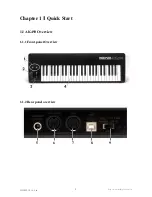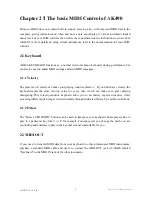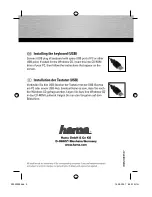
MIDIPLUS Co, Ltd.
4
http://www.midiplus.com.tw
1.3.1 Using the AK490 in your Application Software
Generally with both the Mac and PC, most MIDI applications have a MIDI port configuration or
settings dialog box, sometimes called “MIDI Devices” or “MIDI Setup.” It is within this dialog
box that you will select or enable your MIDI input and output devices.
If the AK490 drivers are properly installed, then the port selection in this case will be the AK490
In-1 (or “Port 1” on the Mac) in the input column, and then AK490 Out-1 (or Port 1) in the output
column. Input 1 (or Port 1), corresponds to the information that will be sent from the AK490
keyboard to your computer. Output 1 (or Port 1), corresponds to the MIDI information sent from
your music application to the physical MIDI output on your AK490 that is marked “USB.” Make
sure that those items are highlighted or checked. The output port that you select on a specific
MIDI track within your sequence will output MIDI information to the keyboard or sound module
or virtual instrument that is attached to that port.
1.4 MIDI Connection
MIDI connectors are standard 5-pin DIN connectors which used to be that connecting a MIDI
device to a computer meant installing a "sound card" or "MIDI interface" in order to have a MIDI
DIN connector on the computer.
If you need to transmit MIDI data from your keyboard to other professional MIDI instruments,
purchase a standard MIDI cable and use it to connect the MIDI OUT jack of AK490 labeled
“Keyboard” to the MIDI IN jack of the other instrument.
1.5 Power supply
Connect an USB cable from your computer to the AK490. The unit will be powered through the
USB connection.
Alternatively, if you do not wish to use a computer get power you can use 6 AA type
batteries.
.
Содержание AK490
Страница 1: ...MIDIPLUS Co Ltd http www midiplus com tw...

























